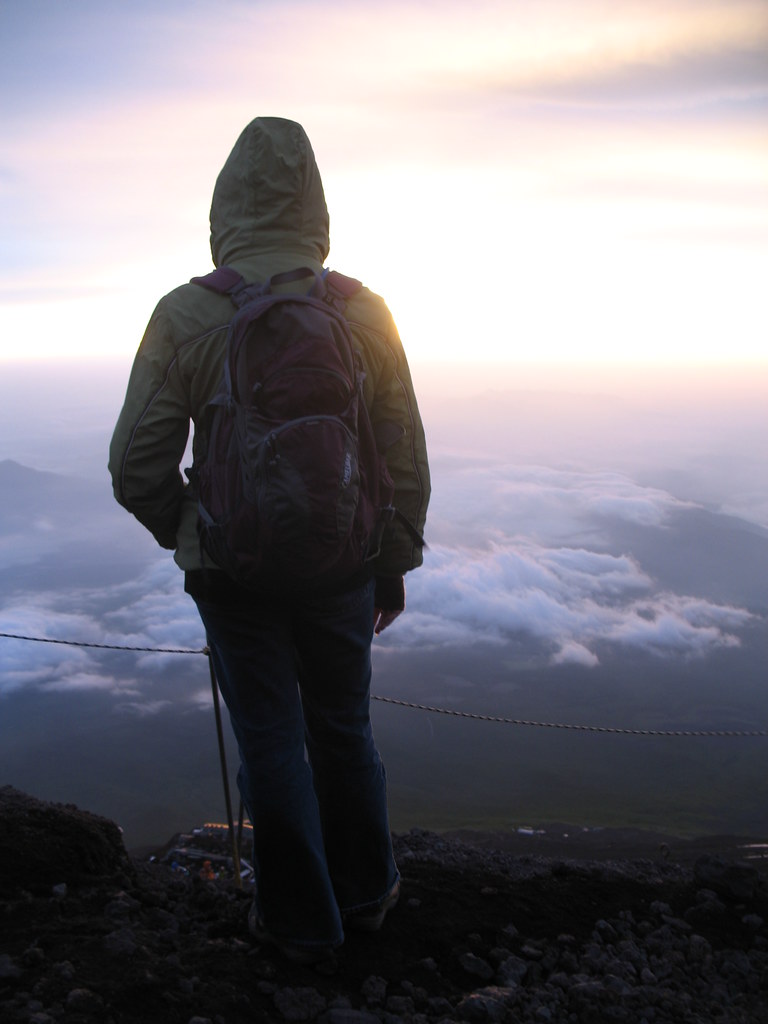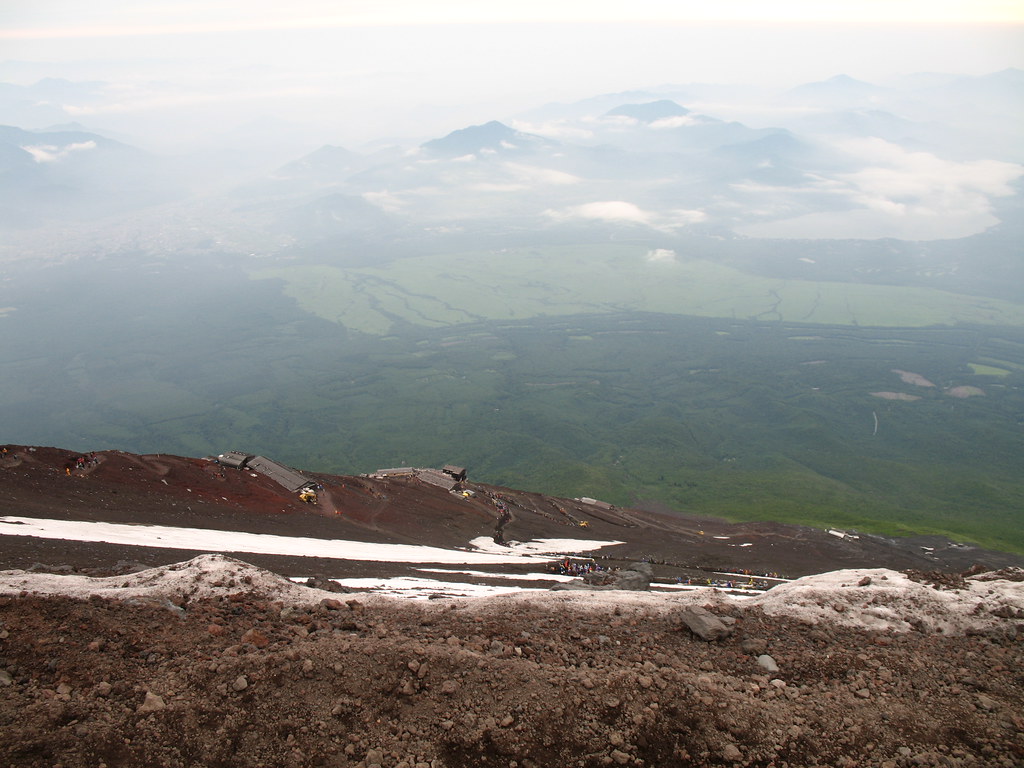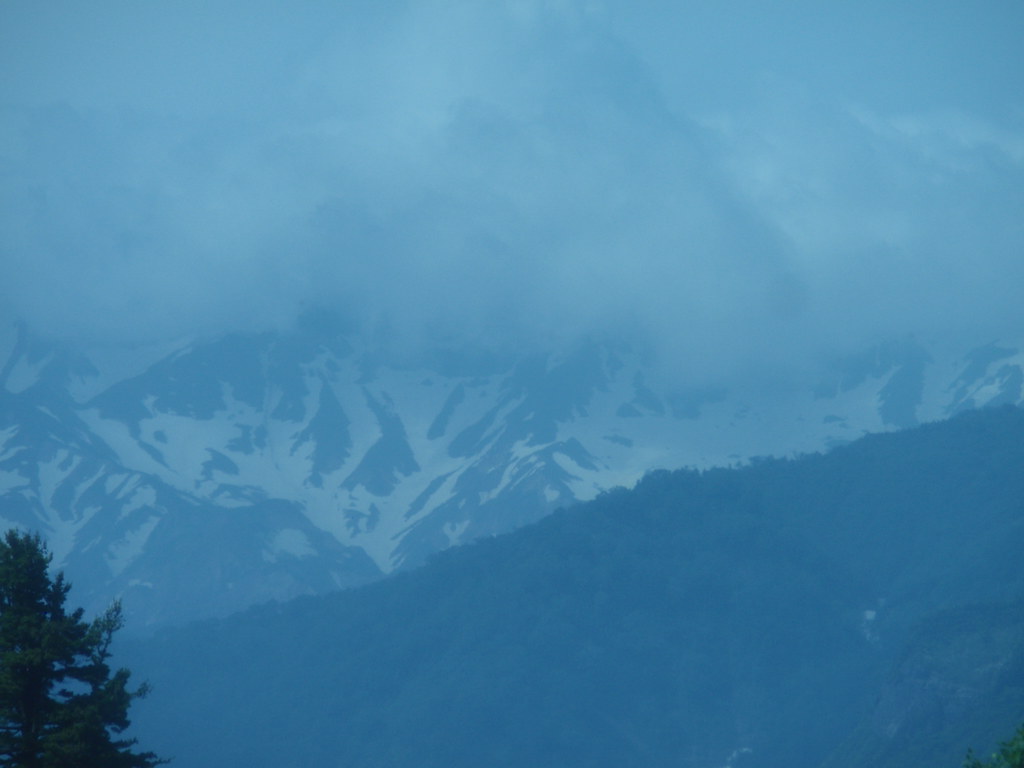Fuji is only open for climbing for the height (heh!) of the summer, in July and August. As this August is spoken for by our trip home and the future is unpredictable, we resolved to climb Fuji this July. There weren't any vacations within reach, so we needed an entire weekend to make the trip. We took the night bus to Tokyo on Friday night, climbed Saturday night (the goal is to reach the top at dawn), and took the train back Sunday afternoon. Informed of probable and possible conditions by the internet and Japanese hiking guidebook, we prepared for rather extreme circumstances. We had learned that the temperature at the summit on a clear, sunny day averages about 40F in the daytime in July, not counting wind chill. We'd be climbing at night, and it regularly rains buckets to boot. The guidebook includes phrases like "freezing cold" and "howling gale". Thus, we brought full-length ponchos to wear over our ski jackets, winter gloves, etc, as well as spiffy new LED headlamps. Our friend Abby adventured with us.
Wearing our headlamps (still low on the mountain - we're not wearing winter clothes)
We'd not previously taken the night bus and must remark that it was largely unremarkable. Big reclining chairs to sleep in (at least big if you're Japanese), but they keep the lights on until they've made all their stops (past midnight) and then play a recorded 20 minute (not kidding) safety briefing in Japanese, followed by a 1 minute safety briefing in English. Not that I wanted it to be longer but somehow I feel like they don't care quite as much about foreigners. Not a terrible form of transit, but I'd probably pay the extra 20% for the night train with sleeper cars if given the option, to be able to lie down fully and close the curtains to eliminate ambient light.
The bus put us bleary-eyed in Tokyo Station at about 6AM. Since our bus to Fuji wasn't until 7PM, we went to the school's apartment and got several additional hours of sleep and then showers, substantially improving our outlook on life.
Figuring that we needed a strong base of food to power us through the nighttime climb, we lunched at the Mexican place in Roppongi that we like. Salsa, ceviche tacos, chicken tacos, tamales, roast pork and roast pork burritos later, we went to the adjacent foreign grocery store to get something to eat. There we armed ourselves with bagels and granola for trail food. It just so happened that the 100% Chocolate Cafe was on the way back to the apartment from there, and the girls deemed a visit essential, prior to returning to the apartment for a second round of pre-all-night-hiking nappage.
Inexplicable chocolate/orange beverage, with flavor of the day choc. square (was banana, and better than you'd think)
After that, it was time for dinner and to catch the bus to Fuji. I thought complex carbohydrates a reasonable dinner idea, but I was outvoted and we went in search of one of Japan's ~6 Burger King locations. Our directions proved totally inadequate (Tokyo is a maze and an address can be completely useless) and we spent a lot of time asking directions before finding it. When we did, they didn't have the chicken tenders that had prompted the quest. We had to run back to catch the bus, which was also very difficult to find (it was the tiny other bus terminal next to the huge bus terminal) before eating. I had two Whoppers and thereafter felt queasy as I well deserved.
Fuji has twelve official "stations" going from the base to the summit. The most common ascent, which we did, starts at the Fifth Station, where the road stops. Starting at Station 1 you'd have a whole bunch of walking to do, which would take a lot longer than we had to do it. From the Fifth Station, it is 1500 meters (.93 miles) to the top...vertically. The Fifth station is already 2300 meters above sea level, meaning the first ~60% of the vertical distance of the mountain is by bus. The summit is over two miles above sea level, and is the highest point in Japan. Even at Station 5, it was already cold when we debarked at 9:30PM.

Going up, together
After discovering that all bathrooms at all stages of Fuji are pay-to-pee (we'd have brought more change if we'd known) we set off. The initial stretch of trail was so sparsely peopled and directed that we thought for a while that we might be off track, but soon enough it became apparent that getting lost much past the Fifth Station would be basically impossible. Stations Six through Twelve, and maybe a dozen facilities not dignified as full Stations (many shared names with facilities fifteen or twenty minutes away, or had names like "Station 8.5") positively lit up the night. We could look up and see a constellation of building lights and bobbing headlamps that just kept going up into the sky. It was clear from looking up at the trail that there were thousands of people on the mountain that night, in a largely unbroken chain stretching from the Fifth Station to the summit. After fifteen minutes, we caught up with the end of that chain and thereafter were, if not surrounded, definitely in company for the remainder of the hike.

Gaijin, out of the wind along the wall of a hut
We met up with some other foreigners (at least 1/4 of the people on the mountain were non-Japanese) who we ended up making the whole way up with, so we had a couple of conversations going on and off most of the night, though the lack of air sometimes took precedence over socialization. The terrain at the bottom was mostly wide, steep ramps of gritty, sandy dirt, sometimes shaped into tall stairs, herringboned into the side of the mountain. This eventually gave way to a mixture of bare rock and fist-sized stones. Hiking did a lot to keep us warm, but as we ascended we kept adding layers, and I was wearing everything I brought long before reaching the top. Blessedly, though, the night was completely clear. I'm not sure that even with the rain gear we'd have made it to the top if it had been raining hard. The cold, gritty wind and the mountain itself were enough to deal with without ice water down the backs of our necks. Some climbers were clearly equipped for hurricane conditions, wearing yellow (or blue, red, or fluorescent) rubber suits head to toe, with elastic straps over them at ankles, waist, wrists, etc.
Here's some in blue, there's one in yellow, and one in red up higher

The ramen was crappy, but warm
As the night wore on, fatigue and cold started adding up, but we kept moving and crossing off stages on the map. We stopped around 300 vertical meters from the top and paid for some really crappy ramen that came with the happy privilege of sitting inside a heated building for twenty minutes. Towards the top the crowds really starting building up, and progress became very slow. We should have made it to the summit with 20 minutes or so to spare, able to get to the true peak by sunrise, but that was not to be. It became apparent that we wouldn't be at the summit at dawn (~4:30AM) but we were between the penultimate Station and the summit, very high up indeed.

The sunrise didn't seem to start at the horizon but in a line the sky - probably clouds reflecting a sun still around the curve of the earth
As the light started coming in everyone turned toward the sun as the sky colored brilliantly, and the world went from grayscale to color as the black mountain and black shapes of other climbers turned rust red and all the colors of neon rainbow, respectively. Of course, the minute the sky began to lighten, hikers stopped in place, in many areas not bothering to leave the trail and forcing those still trying to summit to go around, which accounted for a major portion of the slowdown. Others slowly advanced, taking pictures of every second of the sunrise along the way. We managed to get some too, trying to advance when we could and photograph when we couldn't. Ana and Abby were pretty beat at that point, and considered starting back down rather than making more steps that would need to be retraced, but we stuck together and finished the job around perhaps 5:30 or 6.

The only things more colorful than a sunrise over Fuji are the Japanese hikers taking pictures of it

Looking down at the summit buildings from the highest point
Fortunately for us, they had opened the previously-snow-closed alternate route just that morning, so all those hundreds and thousands of people didn't have to try to go back down the up trail as hundreds and thousands more people were still trying to come up. The down trail was definitely man-made in almost its entirety. Wide, steep switchbacks had been carved into the mountain with construction equipment, and the edges and corners sometimes reinforced with chicken wire or railings. The footing was loose red volcanic gravel almost the whole way down, and it was easy to lose footing and fall on your butt.
Welcome to Mars, watch your step
Note this is really quite high up - look at the countryside below
Also steep
It took three or three and a half hours to step / skid / slide / recover our way down the mountain back to the Fifth Station, and we arrived with half an hour to spare before the bus. Cue celebratory granola and an uneventful trip back to Kanazawa, spent mostly asleep.
Back at base...doesn't look as big from here
For some spectacular shots of the sunrise and a massive collection of other Fuji images, check out the Flickr set.























